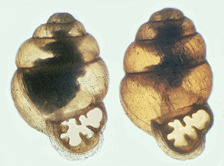Classification
Common name: Ovate Vertigo
Domain – Eukarya
Large, complex cells with complex structures enclosed in
membranes.
Kingdom – Animalia
Eukaryotic, mostly multicellular organisms. Almost are all
heterotrophic and lack cell walls.
Phylum – Mollusca
The second largest invertebrate phylum. Organisms in this
phylum are characterized by a head, a visceral mass, and a
muscular, ventral foot. Most molluscs posses an open
circulatory system with hemolymph (blood). Molluscs also have a
pair of nephridia, which serve to remove excess water and waste
from the body, much like a kidney (Gillis, 2011).
Class – Gastropoda
Largest, most diverse group of molluscs, where V. ovata and
other snails fall. Characteristics of this group include
torsion, which is a 180 degree twisting of the visceral mass.
This brings the anus to the same area as the mouth of the
gastropod, which can cause fouling. Many gastropods have
adaptations for eliminating fouling. Gastropods are also
equipped with a radula, a rough structure on the outside of the
mouth, generally used for scraping food off of a substrate
(Gillis, 2011).
Order – Stylommatophora
Air-breathing, terrestrial land snails and slugs.
Family – Pupillidae
Minute, air-breathing land snails.
Genus –
Vertigo
An ovate (egg-shaped) shell with 5-6 whorls. Members of the
genus Vertigo have only one pair of tentacles and teeth around
their peristome for protection from predation.
Species –
ovata
Named for the particularly round, egg-shaped shell.
To see where V. ovata lives, click
here!

